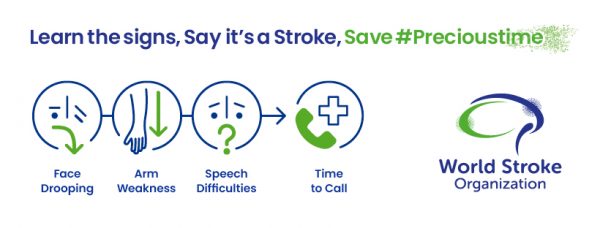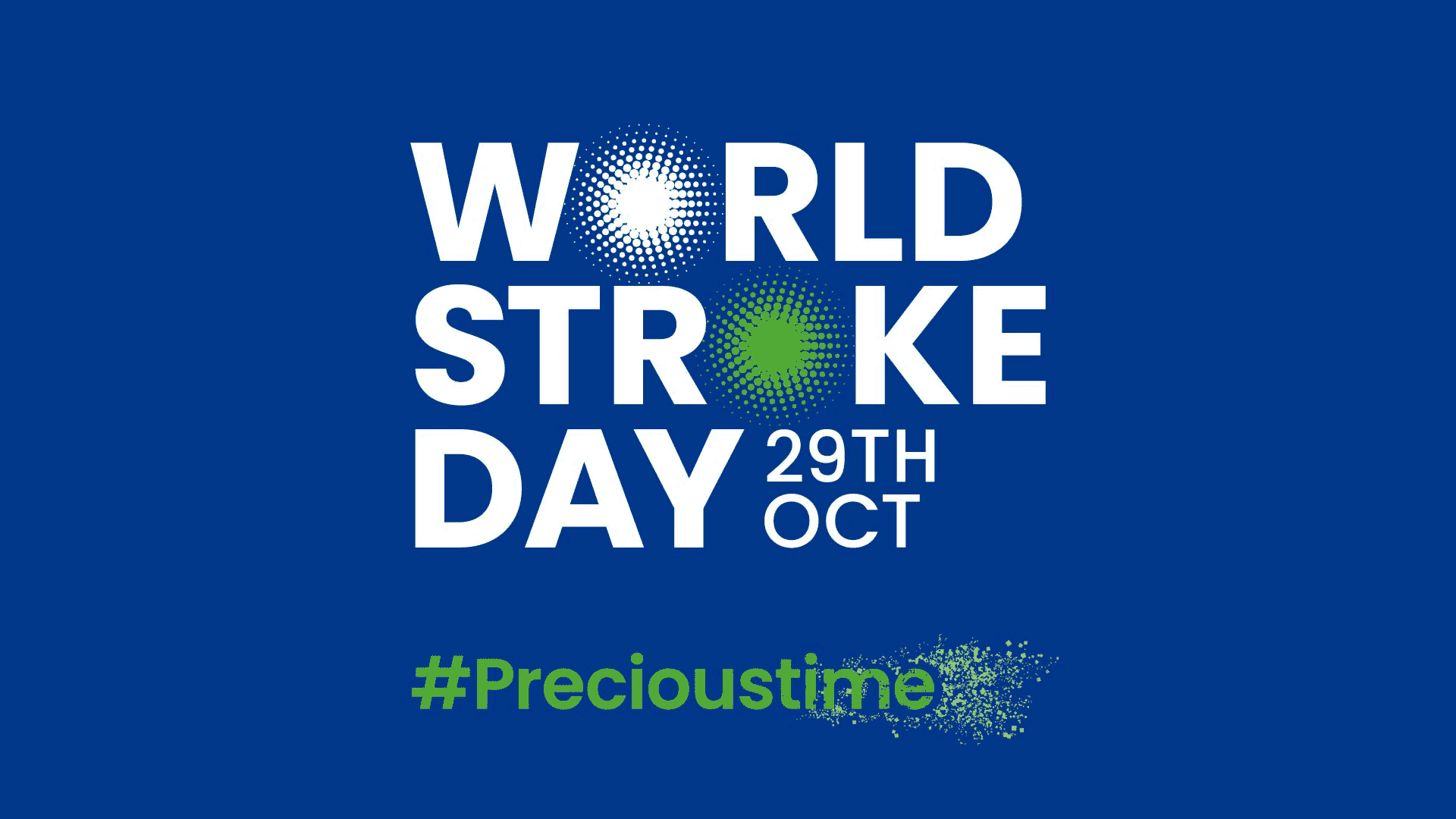Today is 2021 World Stroke Day. A lesser known fact is that anyone can have a stroke; age is not the only risk factor and a stroke can occur in people at any time. In this blog post we’ll learn a little more about primary risk factors for stroke including: medical conditions, lifestyle factors, family history, contraception, pregnancy & migraines.
What is a Stroke?
Stroke is a disruption of blood flow to the brain due to vascular system being compromised. There are two types of strokes. One involves a blockage of an artery resulting in blood flow insufficiency, the other involving rupture of a blood vessel. In both instances, the lack of blood results in lack oxygen to the brain and subsequent damage.
Facts About Stroke
- Anyone can have a stroke; age is not the only risk factor.
- Stroke is a leading cause of disability (1/6 people affected). A large portion of stroke survivors inherit disability that has direct impact of on activities of daily living.
- Stroke is also one of Australia’s biggest killers. It kills more women than breast cancer and more men than prostate cancer.
- A TIA or mini stroke is a manifestation of stroke-like symptoms that last less than 24 hours (as such it is not classified as a stroke). Although in these situations, symptoms may have subsided, this is often a warning sign, and it is strongly recommended that you seek medical attention as soon as possible.
Stroke Risk Factors
Non-Modifiable factors include: Age, Gender, Ethnicity, Family history & Socioeconomic status. Modifiable factors include: Physical inactivity, Smoking, High cholesterol, High blood pressure, Obesity, Physical inactivity, Poor lifestyle choices including excessive alcohol intake and drugs, Diabetes, Psychological Factors (stress, depression), & Cardiac conditions
So how do we recognize the signs of stroke?

Think F.A.S.T. as tissue damage can occur within seconds, therefore early recognition and intervention are important. Contact 000 as soon as possible.
F – Facial droop?
A – Can the person lift both arms?
S – Does the person have slurred speech or difficulty comprehending?
T – Time is critical! – Call 000
What is stroke prevention?
- Primary Management of modifiable risk factors to avoid a stroke from occurring.
- Secondary Management of risk factors following stroke to prevent secondary infarctions.
Prevention strategies/Managing risk factors include:
High blood pressure / Hypertension
High blood pressure (hypertension), is the most important known risk factor for stroke. Hypertension puts a strain on blood vessels, including the arteries that supply the brain causing the heart to work much harder to circulate blood. This can lead to a stroke in several ways:
- damage & weaken blood vessel walls
- speed up common forms of heart disease
- cause blood clots or plaques to break off artery walls and block a brain artery
- The higher the blood pressure, the greater the stroke risk.
Diabetes – Type 1 & Type 2 Diabetes
Our bodies need a hormone (insulin) to turn sugar from our food into energy. If you have type 1 diabetes, your body does not produce insulin. If you have type 2 diabetes, your body becomes resistant to insulin, and therefore does not make enough insulin to keep up. This means your body has difficulty absorbing the sugars from food.
Over time, this can lead to increases in fatty deposits or clots on the inside of blood vessel walls. If untreated or undiagnosed, these clots can narrow or block the blood vessels in the brain, cutting off blood supply and causing a stroke.
High Cholesterol – What is Cholesterol
Cholesterol is a soft, waxy fat that is produced by the body. We also absorb some cholesterol from foods we eat, such as eggs, meats and dairy products. The main cause of High Cholesterol (hyperlipidaemia, dyslipidaemia) is a diet high in saturated fats such as fats from animal foods.
High cholesterol contributes to blood vessel disease, which often leads to stroke. High cholesterol can also be hereditary. There are two types of cholesterol: Low-density lipoprotein (LDL) is the ‘bad’ cholesterol that builds up on the artery walls, while High-density lipoprotein (HDL) is the ‘good’ cholesterol. It is called the good cholesterol because it actually removes cholesterol from the blood stream. It takes cholesterol from the cells in our body to the liver where it is broken down and removed safely from our body.
The ratio of good to bad cholesterol is the key measurement of your stroke risk. The more HDL you have the lower your risk for stroke. When there is too much cholesterol in the blood, it can build up on artery walls and narrow the arteries. This is called atherosclerosis. It can block the flow of blood or cause blood clots, leading to an ischemic stroke.
Heart Conditions
Atrial Fibrillation (AF) is an irregular pulse or irregular heartbeat. With a normal heartbeat the blood is pumped in and out regularly, with all four chambers of the heart completely emptying at each beat. With AF, the upper chambers of the heart (atria) beat rapidly and out of rhythm with the lower chambers of the heart (ventricles). This means the blood does not move through the heart completely or smoothly.
Because the blood is not properly pumped away, a clot can form in the heart. The clot can then break away from the heart wall and travel to the brain, where it may cause a stroke. AF is associated with one in four strokes.
Physical Activity
Exercise helps lower blood pressure and can help you control other things that put you a risk of a stroke. Aim for at least 30 minutes of moderate intensity physical activity on most days of the week. This can be any form of exercise or physical activity, however rhythmic activities using large muscle groups including walking, cycling and swimming are best. The activity should increase your heart rate, make you feel warm and get you a little out of breath.
Moderate intensity exercise is safe for most people but it’s a good idea to check with your doctor first if you have pre-existing medical conditions such as history of stroke or other cardiac conditions. Remember, you don’t have to do your exercise all in one go. Start slowly and build your way up in 10, 15 or 20-minute sessions.
Eating Well – Balance is Key
Making healthy food choices is important for weight management and to prevent conditions leading to stroke. The Australian Dietary Guidelines recommend plenty of:
- Fruit and vegetables. Choose different types and colours. Eat legumes (peas, lentils and beans)
- Grain or cereal foods. Choose wholegrain and high-fibre types of bread, cereal, rice, pasta, noodles, polenta, couscous, oats, quinoa and barley.
- Lean meats and poultry, fish, eggs, tofu, nuts & seeds, peas, lentils and beans.
- Milk, yoghurt, cheese and their alternatives, mostly reduced fat.
Quitting Smoking
Smoking doubles your risk of stroke. The more you smoke the greater your risk of stroke. Tobacco in every form is very harmful to your health and exposure to second-hand smoke is also dangerous.
There are immediate health from quitting smoking. Within a month after a person stops smoking, blood pressure returns to its normal range. The risk of heart attack and stroke starts to drop immediately after a person stops using tobacco products and can drop by as much as half after one year. After 15 years your risk of stroke and heart attack is almost the same as that of a person who has never smoked.
Alcohol Moderation
Do you know your alcohol limit? Drinking large amounts of alcohol increases your risk of stroke through increased blood pressure, type 2 diabetes, obesity and irregular heartbeat (atrial fibrillation).
Drink no more than two standard alcoholic drinks on any day to reduce harm from alcohol-related disease or injury. Check the label on cans and bottles to ee how many standard drinks you are actually consuming.
Medical Management
Dont forget to book in with GP for health check and also ensure you are taking the correct medications to manage your conditions. Don’t ignore the warning signs, call 000 if in doubt.
Summary
More than 80% of strokes can be prevented. Management of your modifiable risk factors can prevent you from having a stroke and you can improve our risk by following all the tips mentioned above.
Alliance Rehabilitation are your local experts in stroke recovery and prevention – contact us today for information on our services or any of the following programs suitable for those suffering the effects of Stroke:
- Tyromotion Upper Limb Retraining Program
- Constraint Induced Movement Therapy (mCIMT)
- Skills To Enable People and CommunitieS (STEPS) Program
- Drive Your Own Recovery
- Driving Remediation & OT Driving Assessment

